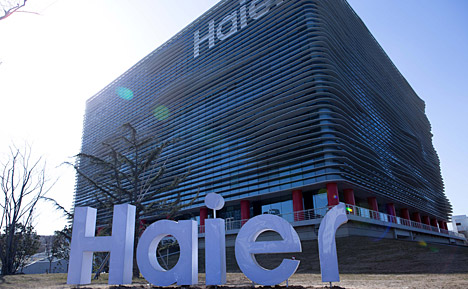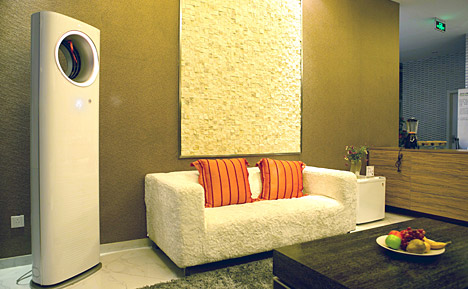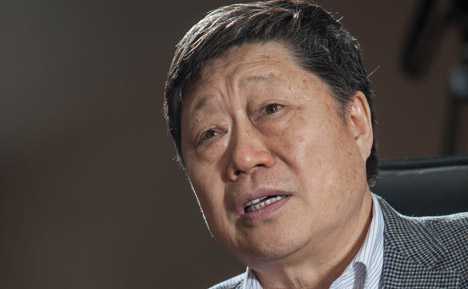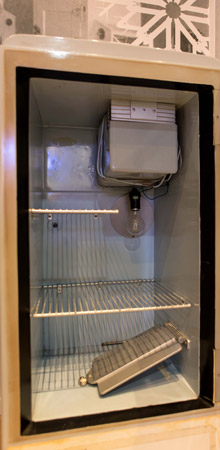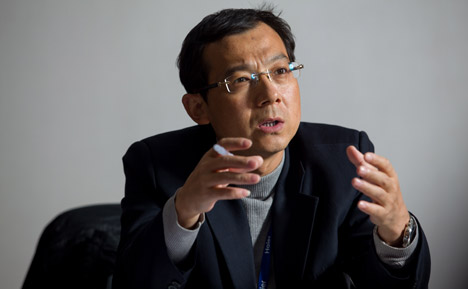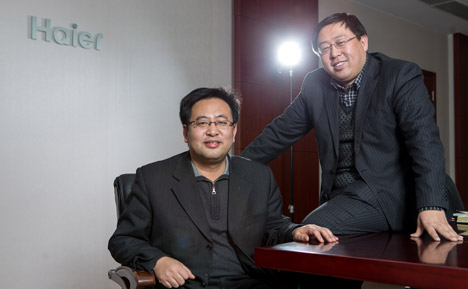The Haier Road to Growth
Customers always come first for this Chinese appliance maker — even as it continually reinvents itself and expands around the world.
Start with 30 million responses on your QZone, Tencent, and other social media platforms — all to a simple question: “What do you want in air conditioning?” Then pay attention to the more than 670,000 people who take part in the online conversation that follows. You’re bound to come up with something cool — or, more precisely, “cool, not cold.” This concept, drawn from online responses, became the tagline for the Tianzun (“Heaven”), Haier’s advanced household heater/air conditioner/air purifier, released in 2014. Many Asian consumers don’t like the chilling effect of conventional temperature control. They’d much prefer to be “cool, not cold.” But there’s more to the concept than temperature. Air from most such devices in China is dry and dusty. The machines themselves are too noisy, or too likely to spread disease (bacteria live in air conditioning systems). Moreover, the machines look — well, like air conditioners.
The Tianzun doesn’t have any of those drawbacks. It is an obelisk-like device with a small wind tunnel that draws air through it from the room where it is positioned. It has an Internet connection, so consumers can use their smartphones to warm or cool the room while on their way home. Some consumers probably knew they wanted that feature, but they didn’t know that they wanted to see the circle’s light shift from red to blue as their air quality improved. Once they saw that happening, they were hooked. The product is targeted directly at a consumer segment that no other company, in the West or the East, has recognized, and that could end up being much bigger than a niche.
By building cooling machines based on this in-depth and multilayered approach to consumer insight, Haier is following its own core principle: “customer service leadership,” or the necessity to shape the future by giving customers what they want most (but may not have yet realized they can ask for). Even the decision to use the phrase “cool, not cold” in its Chinese advertising campaign reflects this principle. These are the words that customers use themselves, as opposed to a slogan dreamed up by a marketing professional.
Just as unconventional was the cross-functional nature of the appliance’s launch. While the marketing staff digested the insights gained from Haier’s online customer interactions, manufacturing was already considering what they would mean for production, procurement was speaking directly to suppliers about sourcing feasibilities, and after-sales service was developing plans for follow-through. Because they worked closely together from the start, managers from all these functions were moving forward in concert, addressing possible disconnects as they arose. This allowed products to go to market as soon as they were designed and developed, instead of waiting for each department to throw its work “over the wall” to the next one. Meanwhile, representatives of each company function conducted conversations directly with customers, thereby adding a responsive new dimension to the company’s consumer insight capabilities.
Haier’s rapid introduction of the Tianzun air conditioner is typical of the company’s track record since the late 1990s. The company is known for several distinctive capabilities: a precise understanding of consumer needs, especially in China and other emerging markets; the ability to rapidly innovate new types of appliances that meet those consumer needs; the management of complicated distribution networks, a skill honed in the complex Chinese market; and a high level of execution ability, including the automation of factories to deliver products to consumer specification. (See “Haier's Capabilities System,” below.) These attributes have served it especially well in China, allowing Haier to outcompete more experienced appliance companies such as Whirlpool and Maytag in that country. In fact, Haier’s prowess — and particularly its emphasis on “what we can do and who we are” rather than on “what we sell and how we make money” — shows the kind of capabilities needed by companies that were founded in emerging economies if they are to succeed in the global sphere.
Haier’s Capabilities System
Haier is one of 12 companies that were studied closely in a Strategy& research project on distinctive capabilities and coherence.
Value Proposition: Haier’s “way to play” in the market (its value proposition) has gradually broadened since Zhang Ruimin became CEO in the mid-1980s. The company first took the role of a category leader, maintaining top market share because of its reputation for quality in China. Then it became a customizer (adapting its products to customer demands) and a solutions provider (helping consumers manage issues like water quality and home design). Haier now sells not just home appliances but related services, adapted to consumer demand in China, and, increasingly, other markets. Haier delivers its way to play by excelling at four differentiating capabilities.
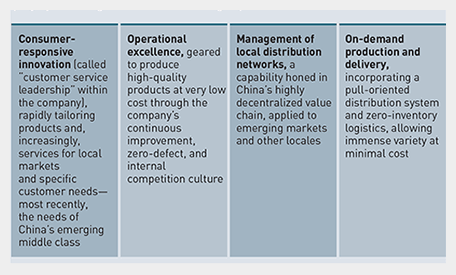
- Source: Strategy That Delivers, by Paul Leinwand and Cesare Mainardi with Art Kleiner (forthcoming from Harvard Business Press, 2016)
Haier is now the fastest-growing provider of appliances in the world. Since 2011, it has held the largest worldwide market share in white goods. With its upscale brands in China, such as Casarte, and its growing presence in the United States, Europe, and Japan, this US$38 billion company has moved out of the value-priced and niche appliance domain to compete directly with top-of-the-line appliances from more established companies. It has accomplished this by being a consistently coherent and capable company: staying true to its core identity as a company dedicated to solving problems for consumers, while continually reinventing itself with imagination and verve.
Customer Service Leadership
Much of the credit for Haier’s success accrues directly to Zhang Ruimin, the company’s CEO since 1984. Throughout the 30 years of his tenure, his sharp focus on customer service leadership has given the company consistency even as it propels Haier through dramatic changes. Zhang was the leader who proposed that Haier should never see itself as just a manufacturer of products, but instead as a provider of solutions to its customers’ problems. In the earliest years, that meant bringing new levels of quality and reliability to Chinese products. Later, it involved increasingly sophisticated forms of customization and new types of services. Through its simplicity and continuity, this principle has given all employees a reliable compass with which to make decisions, even in the face of disruptive market challenges such as new technologies or new competitors.
To accomplish its goal, Haier has consistently cultivated and rewarded high-quality talent; the company has been a magnet for many of China’s most capable engineers and businesspeople. This approach is especially noteworthy within China’s cultural and social context. In a country that was just beginning to emerge from a Maoist mind-set when Zhang took the helm, the idea that success depended on the entrepreneurial efforts of individuals, recognized for their differences and rewarded for their achievements, was relatively unfamiliar. Haier has thus invested a great deal, especially for a Chinese company, in training its employees and demanding innovative ideas.
Despite the success it has achieved, and its willingness to stick to one core value proposition (and one CEO) since the 1980s, the company has never become complacent. Zhang established early on that changes would be a way of life, not soon-to-be-completed episodes that must be traversed. “The only thing that we know is that we know nothing,” he says. “If you don’t overcome yourself, you will be overcome by others.”
Indeed, Haier has reinvented itself at least four times. The first reinvention, in the 1980s, was the decision to differentiate the company by the quality of its products. The second, in the 1990s, was the adoption of consumer-responsive innovation, starting with (but not limited to) products for particular customer needs. The third, which took place in the 2000s, was the reorganization into a bottom-up structure, in which self-managing teams led decision making. The fourth, going on today, is the reinvention of Haier as a truly Internet-based company, open to the world in a way that few other companies have attempted, let alone realized.
Haier is reinventing itself as a truly Internet-based company.
Zhang did not develop this management approach on his own. From the beginning, he displayed a fervent curiosity about management and high performance, and he studied the work of leading scholars and observers, especially eminent management writer Peter Drucker. He took from Drucker, for example, the idea that the purpose of a business is not making money, in itself, but attracting and meeting the needs of customers. If a customer wins by gaining a better product or service, then everyone else should win as well, including the organization’s shareholders through increased profits, and the employees through increased income. A visit to Qingdao with Zhang and his associates can take the form of a management seminar; visitors are subjected to relentless questioning on management innovations that might be of interest to Haier. Zhang often takes his own notes, and he frequently applies the concepts to Haier — first in small experiments, and then rolled out through the company.
Building a Quality Brand
Haier, founded in the 1930s, was nearing bankruptcy in the early 1980s, when Zhang brought it back to life. At that time, demand for appliances was slowing down in the West after 35 years of growth. Looking to recoup, Western manufacturers cast covetous eyes on China’s emerging market. Most Chinese families lacked basic home appliances, and the offerings from local manufacturers did not meet basic standards for quality or consumer appeal. With their strong brands and relatively sophisticated technology (the automatic refrigerator icemaker and microwave oven had recently been introduced), overseas manufacturers believed that they would have an easy time in cities like Guangzhou, Beijing, and Shanghai.
But Chinese domestic firms fiercely defended their home markets by drastically reducing prices. Most of the foreign competitors, and quite a few of the emerging Chinese manufacturers as well, could not compete. General Electric chose not to enter the China market at all because it foresaw the price war. One of the Chinese companies that won this round was the Qingdao Home Appliance Company, a small collective enterprise that had made various electronic devices, including washing machines, but had recently settled on refrigerators. It had changed its name repeatedly over the years, but had always been located in Qingdao, a port in the Shandong province of northeastern China, midway between Beijing and Shanghai.
The appetite for refrigerators was so strong in China that Haier sold just about everything it produced. The Chinese consumer in those days expected poor quality and was prepared to have any new product repaired almost immediately. Nonetheless, the company was moribund. Its production line delivered only 80 units per month, including many that didn’t work. The factory was so run-down that workers had to be told not to relieve themselves on the floor, and they burned parts of the walls for heat. After three managing directors resigned in rapid succession, a 35-year-old deputy manager in the company named Zhang Ruimin was asked to find a replacement. He found no acceptable candidates, and reluctantly took up the challenge himself. But this appointment turned out to be fortuitous. Zhang was a visionary who saw that a middle class would emerge in China, a public interested not just in refrigerators, but in high-quality, branded, innovative products — made in China, but as good as or better than their Western-made counterparts.
Soon after Zhang took the role of managing director, a customer wrote a letter to the factory complaining about a faulty refrigerator. This led Zhang to one of the most famous episodes of his career. “I called people from quality control down to the warehouse with me,” Zhang later recalled. “We had just over 400 refrigerators in the warehouse. We inspected them one by one. If they had any problem whatsoever, we pulled them out. We ended up pulling out 76 problem fridges. I had to change the perception [of our quality]: If products left the factory, they should be first rate.”
Zhang had his incredulous employees line up those 76 defective refrigerators in the street outside the factory and publicly smash them to bits with sledgehammers. They all knew he could have sold them, or given them as political favors to local officials. But the message was clear. Never again would the Qingdao Home Appliance Company sell products it could not be proud of. Instead, it would build appliances that solved problems for its customers — the first problem being the unreliability and poor quality of refrigerators in China.
Soon after, in 1985, the company reestablished itself as a joint venture with the German manufacturing company Liebherr, thus gaining access to advanced technologies. It changed its name to Qingdao-Liebherr to evoke the prestige and quality of German manufacturing. In 1992, it solidified this association by renaming itself Haier, a name the company kept even when the joint venture ended. Haier, a simplified Chinese transliteration of the second part of the German Liebherr, was chosen in part because it was easy to remember and euphonic in both Chinese and English.
As part of the company’s first reinvention, a number of mutually reinforcing, granular management choices provided guidelines for day-to-day practice that made change easier to accept. To improve quality, for example, Zhang set out to foster a mind-set oriented toward performance and accountability. He borrowed routines and practices for continuous improvement from the quality movement — which was then, in the mid-1980s, first becoming visible in industries outside Japan. Zhang also linked pay to performance in a manner previously unseen in the Chinese market, through a system called “Overall Every Control and Clear” (OEC). Every day, workers tracked quality results using paper and pencil, and their wages were tied directly to the outcomes. This gave the company a simple means of establishing goals and controlling achievement for “everything, everyone, and every day,” and a way to encourage employees to constantly challenge their previous performance.
For the next 30 years, the operational capability of OEC gave Haier what behavioral experts George Kohlrieser, Susan Goldsworthy, and Duncan Coombe call a “secure base” on which to build bold change. For example, the company managed logistics with a zero-defects focus, resulting in very low inventory, short delivery times, and low working capital. In the years that followed, as new business models were introduced, the disciplined mind-set of OEC was never abandoned. Instead, it was scaled up to meet ever more ambitious goals. Workers grew accustomed to taking small steps that added up to great results.
The Niche Innovator
In the late 1990s, a farmer in the Chinese countryside complained to Haier that his washing machine was full of dirt and was not functioning well. The local distributor sent a technician to the farmer’s house, where he discovered that the farmer had been using the washing machine not to wash clothes but to clean sweet potatoes. At this time, agricultural markets had been permitted to open in China, and cleaner vegetables commanded higher prices. The repair technician reported immediately to Haier’s headquarters about this practice, which was growing increasingly common in the region. Inspired, the company soon released a vegetable washing machine, designed to accommodate the extra grime and soil of the tubers.
Around the same time, Haier’s researchers observed that unlike Western consumers, many Chinese people hand-washed their underclothes every day at home. They found it more hygienic and socially discreet to wash these separate from other clothes and away from public washing machines. In response to this consumer need, Haier launched a small, low-energy washing machine called the Little Prodigy that could easily fit into a small, crowded urban apartment. The machine became extremely popular, among, for example, families with newborn children.
These episodes represented the start of the second reinvention at Haier: a new form of customer-responsive innovation. This was timely, because quality was no longer a great differentiator in China; other companies had caught up. Zhang built upon the company’s hard-won workforce discipline, and the accompanying performance–pay relationship, to link employees directly to customers. To break down the “invisible walls,” as he called them, between functions, Zhang assigned teams made up of members of different functional departments to specific projects. He avoided the conflicts of a matrix structure by introducing “market chains” (based on the value-chain concepts of Michael Porter), in which it was possible for all individuals at Haier, no matter what their role, to trace their actions directly to the marketplace. These market chains replaced functional silos as the key organizational unit.
This was also the phase in which Zhang began building Haier into a global company. He approached this challenge by adopting Mao Zedong’s strategy of “occupying the rural areas to encircle the city,” gaining strength first with niche products for sectors where there were few competitors. The company took full advantage of its customer-responsive innovation capability to do this. In 1997, recognizing the needs of college students in dormitory rooms, it launched mini-refrigerators in the United States. It followed with wine refrigerators in 2004. And then, during the 2000s, Haier parlayed that success into becoming a mainstream producer of appliances for the U.S. market. Meanwhile, in Pakistan, Haier sold extra-large washing machines designed for heavy robes.
Key to all this growth was Haier’s behind-the-scenes customer-centric operations system. Rapid innovation based on consumer demand — as with the Tianzun air conditioners released in 2014 — has become routine, because all departments work in parallel. The company’s close collaboration among R&D, marketing, and sales also works well in the U.S. market. For example, U.S.-based R&D engineers are required to talk directly to consumers in the design of new products, and their salary is linked to the sales results of the products they design.
Intimacy and Entrepreneurship
In 2005, Zhang recognized that most of Haier’s competitors in China were achieving acceptable levels of service responsiveness and that the company would once again have to reinvent its value proposition. He believed that Haier suffered from unnecessary time delays and guesswork about new product manufacturing volumes, which proved costly when it guessed wrong, and that could be reduced, if not completely avoided, by becoming more intimately aware of customer needs and wants. Employees would now have to get to know the customer better than they knew themselves, or, as Zhang put it, to “create zero distance with the customer.”
Intimacy is a lot more complicated than responsiveness, and this third reinvention required employees to feel closer to their customers. Haier thus inverted its organizational structure into one based on self-organizing work units called ZZJYTs (an abbreviation for zi zhu jing ying ti, which translates to independent operating unit). Their three most critical functions — marketing, design, and manufacturing — were now supposed to work directly for customers. Instead of directing the employees who did that work, the ZZJYT managers became service providers to them, giving them the resources and guidance they needed to provide for customers. This minimized the decisions made at higher levels in the hierarchy, making the company more responsive to nascent market needs. Zhang went so far as to announce that this shift in organizational model would proceed even if revenues and profits showed signs of flagging, and even if it were necessary to use some of the returns from successful legacy offerings to make it work.
The new structure proved successful, and the ZZJYTs are still the basic organizational unit at Haier. Each comprises a team of 10 to 20 people — sometimes located in one place, other times virtual — who come from various functional roles and are brought together for a specific mission, and who are given profit and loss responsibility and accountability. They have their own independent accounting systems and complete autonomy in hiring and firing employees, setting internal rules about expenses and determining bonus distribution, and making almost any operational decision that typically would be made by an independent functional organization.
Haier organizes its ZZJYTs in three tiers. First-tier ZZJYTs have the task of directly facing the market, understanding customer needs, and providing customers with the right products. Second-tier ZZJYTs are responsible for supporting the first-tier ones, providing them with the resources and the guidance they need. Third-tier ZZJYT managers are the business division managers or functional managers who set corporate strategies and direction for the whole group. A typical first-tier ZZJYT is composed of sales, R&D, marketing, and finance people. Everyone, whatever their function, is expected to talk to consumers regularly.
To Zhang and others at Haier, this organization design represents an explicit effort to avoid being disrupted by technological change. They wanted to make sure that top management would heed early warning signals of disruption, especially those that came from internal staff, and adjust to new realities rapidly and painlessly. Thus, at Haier, the time of information flow between the customer (the top) and coordination (the bottom) is minimized. Because R&D and marketing people work in the same ZZJYTs, they meet frequently, particularly when new products are considered. Salespeople keep in close touch with customers, so they can estimate the order numbers with a smaller variance than if they were relying only upon forecasts. Once the products are ready for shipment, they go first to the waiting-list clients, and only afterward to retail outlets. This way, Haier keeps inventories low, which saves storage costs and working capital.
The ZZJYTs are not permanently assigned to a particular product or role. Instead, they are formed through internal competition; participants must apply to work on projects that appeal to them. Winners are chosen on the basis of the quality of their product or service ideas, the attractiveness of their business model, and the feasibility of their go-to-market planning. When Haier made the strategic choice to launch a three-door refrigerator, for example, it invited its employees to compete for the role of leading this initiative by submitting business plans and business models explaining how such a product could best succeed. The company’s $1.5 billion three-door refrigerator business is now led by the winner of that competition, 38-year-old Pu Xiankai. He was selected, despite his relative youth, because he described the product in an imaginative way. Once appointed to this position, it was incumbent upon him to select a team and to find manufacturers and marketers within Haier to produce and sell his products. Today, he oversees what Haier calls a “community of interest,” that is, people throughout the company, and external partners along a value chain, who have made a commitment to help his team.
The activities of all the ZZJYTs are linked by internal contracts. For example, if the three-door ZZJYT needs market research data about a certain region of China, it entertains proposals from the several marketing ZZJYTs that provide such services, as well as looking outside Haier. The ZZJYT leaders also know that they cannot develop all the cutting-edge technologies they need in-house. Therefore, willingly embracing the concept of open innovation, they collaborate with organizations everywhere they operate — which is how the company ends up working with the best universities and research institutes in the world.
To provide talent for the ZZJYTs, Haier created an internal labor market. Now the right number of employees with the right skills gravitate to the right organizational positions at the right time. Instead of offering its employees jobs, the company offers everyone a continuing series of opportunities to find jobs, considering the contributions they have already made. “The level of scrutiny takes some getting used to,” says Fu Haining, the chairman of the LongLongigo group, which operates Haier retail stores in China. “In the beginning, it can be a little painful, because the culture of constant challenge can make you feel like what you’ve done, what you’ve achieved, isn’t recognized. Later, you come to realize that this is what it takes to stay ahead in an extremely competitive market.”
An Internet-Based Platform
After its first three reinventions, Haier looked nothing like a conventional modern complex organization. Its culture — embracing rather than resisting change, while holding true to its original core principle of customer service leadership — is the most important asset of the company today.
But Zhang, in recent years, has questioned the ability of even this level of innovation to succeed. Inspired by the success of the latest wave of Internet-based companies, he is currently launching a fourth reinvention, this one involving the Internet. This is known at Haier as the “networking strategy.” Even the ZZJYTs, the focal point of the previous wave’s business model, are slated for dramatic change. Zhang has proposed eliminating the current second-tier ZZJYTs, presently home to most of Haier’s middle managers. The company would instead become a collection of platforms, each able to adjust to changes in the consumer market by drawing on support and collaboration from the others.
This new Haier approach involves opening up the company to intensive collaboration not just with customers, but with innovators around the world — including with competitors. “The platform helps us attract first-class resources,” says Lei Yongfeng, the R&D director for PAC, Haier’s air conditioning platform. “It could be R&D resources based at a university or at a technology company. In the past, our relationship with a supplier like Mitsubishi might have consisted of us going to them and giving them the specs for a new air conditioning compressor. Now, they can see for themselves what our customers are asking for. The direct view they get makes them more responsive, which in turn helps our innovation efforts.”
Water purification is another example of the increasing scope of Haier’s collaboration. The company entered the business through a joint venture with the Strauss Group, an Israeli technology firm, which provided the technology while Haier focused on marketing, distribution, and service. But then Haier broadened its platform to include many other R&D partners; for instance, it shares more than 20 water purification patents with Dow Chemical.
The result is a new level of proficiency that goes beyond anything Haier has done before. For example, the company now uses Internet access to customize every product it sells in China, whether bought in a store or online. Customers choose the color combinations, features (such as the number and layout of shelves in the refrigerator), and ancillary design elements (like the pattern of sparkles on a high-end appliance). Factories routinely make them to order. The process is not unlike choosing the accessories on a new car, except that there tend to be more choices.
The Internet connection also makes customers more likely to buy a water purifier — which is sold only by consultation. Haier reps are trained to look up the complex data on China’s water problems, which vary by neighborhood, and to install the filters that guard against that neighborhood’s mix of chemicals and pollutants. On its website, which has an active consumer-to-consumer dialogue, the company posts water quality information for 220,000 communities in China. “We want people to be able to find all their water-related answers at Haier,” says Qu Guinan, the general manager of the Haier water treatment company. Building on its success to date, the company is now exploring partnerships with local communities to manage their water purification efforts community-wide.
The Internet has enabled the company to expand its service diligence; it provides intensive installation as part of any appliance sale (a rarity in China), and, using monitoring signals from the appliances, it conducts follow-up calls with customers when the equipment is not working. The company also keeps in touch personally just in case the monitoring has missed some cause of dissatisfaction. The connection to customers has helped Haier migrate many people from their medium-value line of household appliances (the original Haier) to the more upscale Casarte brand. The phrase “the information is more valuable than the product” has already become a slogan throughout Haier.
“We’re providing information to Chinese households,” says Jiang Hanke, social media director for the water purification platform, “but we’re also benefiting from these interactions. They give us a better understanding of users’ needs. Users can see what the water-quality situation is in their communities and use that information to select filtration products that suit them best. Although we didn’t set up the online resource with the direct goal of making sales, it has had that effect; sales in this still-young business have risen by a factor of four since we’ve introduced the online resource.”
Zhang recognizes the high stakes that are involved in changes of such magnitude: “There will be an earthquake [within our company] if it is not properly handled.” But he also believes it is the only course of action that will allow such a large company to succeed in an era when each new triumph leads to new problems. The goal of a large company, he says, is to “lose control step by step.” In other words, Zhang believes that Haier isn’t unique. Every major organization will have to learn how to maintain its identity, the quality of its products and service, and its customer relationships, while being prepared to give up everything else. Haier’s role in this new world will be as a pathfinder: It’s already the first leading global consumer manufacturing company from China. Soon, if Zhang is once again correct, it will be the first company from anywhere with its distinctive, innovative form of management.![]()
Author profiles:
- Bill Fischer is a professor of innovation management at IMD in Lausanne, Switzerland. Previously, he was the executive president and dean of the China–Europe International Business School in Shanghai. He is a coauthor of Reinventing Giants: How Chinese Global Competitor Haier Has Changed the Way Big Companies Transform (Jossey-Bass, 2013).
- Umberto Lago is an associate professor of management at Bologna University in Italy and a coauthor of Reinventing Giants.
- Fang Liu is an investment analyst at Lombard Odier Asset Management, a former research associate at IMD, and a coauthor of Reinventing Giants.


